Time Management: The 90-Minute Rule of Scheduling

We often lie in bed at night and think “Right. Tomorrow I’m going to be productive. I’m going to check everything off of my list: wake up early, cook a healthy breakfast, organise my desk, answer all of my emails, crush my deadlines, go for a run…” and the list goes on. Often we end up waking up with that same motivation but quickly become distracted and achieve less than half of what we set out to do. This can leave us feeling frustrated and cause us to put our tasks off until tomorrow once again. Rinse, repeat and what do you have? Well, you’ve got poor time management. Don’t worry, most of us do too.
In Harold L. Taylor’s Time Management for an ADHD World, the author breaks down our most common distractions and provides us with concrete skills to beat them.
One example of this is Taylor’s “90-minute rule of scheduling” which he introduced in his book, Time to be Productive, (Bookboon.com, 2012). Taylor says this rule is even more important in light of today’s distractions.
Break Your Day Up
Taylor advises us to break the day into segments, grouping similar activities into these segments. The first 90 minutes of the day might be dedicated exclusively to priority tasks, the second segment to checking and responding to e-mail, text messages, voicemail, personal communications, and the third segment to lunch, exercise, and relaxation and so on – with no overlap of segments.
Dedicate Time to Avoid Distractions
Committing 90 minutes to one task means trying not to answer the phone, send a text, check social media or e-mail, during your first “priority” segment of time. Checking your phone or jumping on social media at that time could easily cause you to take off on another tangent and all the next thing you know you’re 20 minutes deep into a badly-run meme page and wondering where the time has gone.
Take breaks
Cut yourself some slack. Your brain can only focus for 90-120 minutes at a time. Make sure to schedule short breaks between your 90-minute segments. Stretch, go for a walk, grab a coffee, do some drawing, distract a co-worker or read the news before you launch into your next 90 minutes.
Find Your Prime Time
It is best to schedule your priority segments during your “prime time”, the part of the day when you feel most energetic, enthusiastic and mentally alert. Identifying which part of the day your productivity peaks is a great way to prioritise your time. Prime time for most people is the first thing in the morning but not everyone works that way. The best way to find out whether you’re a night owl or an early bird is by listening to your body. Track which part of the day you feel the most energetic, motivated and focused and you’ve identified your prime time.
By sticking to the 90-minute rule of scheduling, you will eventually form a habit which will allow you to fall asleep at night feeling accomplished and confident that the next day will be just as productive as the last.







